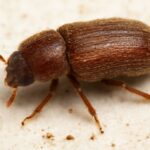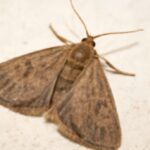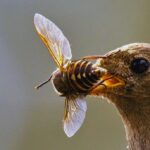Keep Your Garden Safe and Thriving
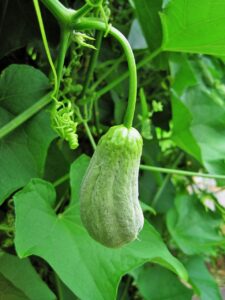
If you grow squash, zucchini, pumpkins, or gourds, you’ve probably heard of the squash vine borer—or maybe you’ve already battled this sneaky garden pest. One day your plants look healthy and green. The next day, they wilt as if someone cut off their water supply.
The culprit? A fat, white caterpillar living inside the stem, eating it from the inside out.
But here’s the good news: You can prevent squash vine borers before they destroy your crop. With the right strategies, you’ll enjoy healthy vines, more fruit, and a much less stressful gardening season.
This guide will walk you through what squash vine borers are, how to spot them early, and the best prevention tips that actually work.
What is a Squash Vine Borer?
Squash vine borers (Melittia cucurbitae) are moths in disguise. Unlike most moths, the adults are active during the day and have bright orange bodies with clear wings.
The real trouble starts when the female lays tiny reddish-brown eggs near the base of your squash plants.
Once the eggs hatch, the larvae then bore into the stem and begin feeding on garden plant’s tissue. This blocks water and nutrients, causing the vine to wilt and die—sometimes overnight.
Why Prevention is Better Than Cure
Once squash vine borers get inside the stem, it’s very hard to save the plant. You might be able to perform “vine surgery” to remove the larvae, but the plant often suffers permanent damage.
That’s why preventing the problem from the start is the smartest approach.
Preventive measures protects, your harvest, and your gardening gardens health.
Signs of Squash Vine Borer Damage
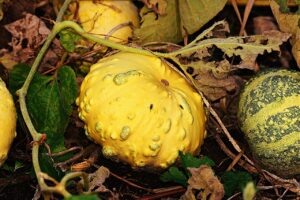
Before we jump into prevention, it’s important to know what to watch for:
-
Sudden wilting during the day (plants may perk up overnight, but wilt again)
-
Frass (sawdust-like droppings) is noticeable near the base of garden plants.
-
Small entry holes in the stem
-
Thick stems that feel hollow or mushy when squeezed
-
Decline in plant health despite watering and fertilizing
If you see these signs, act fast—but ideally, you’ll stop the borers before they move in.
Best Squash Vine Borer Prevention Tips
Here are proven, gardener-approved ways to keep these pests from taking over your squash patch.
1. Know the Life Cycle
Understanding when squash vine borers are active is key. The moths emerge in late spring to early summer, just in time to lay eggs on young plants. Once you protect your garden plants during this period, you can discourage or break the cycle of these garden pest.
Tip: Check your local extension service or gardening calendar for timing in your area.
2. Use Floating Row Covers
Row covers create a physical barrier between your plants and the moths. Place them over your squash plants right after planting.
Keep them in place until the vines start to flower, then remove them so pollinators can do their job.
3. Plant Early or Late
In some regions, you can outsmart the borers by planting earlier so the plants mature before moth activity peaks. Alternatively, planting later in summer after the moths are gone can also work.
4. Wrap the Stems
Wrapping the base of the plant’s stem in aluminum foil or nylon stockings will create a protective shield. This makes it harder for the female moth to lay eggs directly on the plant.
5. Rotate Your Crops
Don’t plant squash in the same spot every year. Squash vine borers overwinter in the soil as pupae, so rotating crops helps reduce the risk of infestation.
6. Check for Eggs Daily
During the egg-laying season, inspect the stems near the soil line every morning. Squash vine borer eggs are very tiny and reddish-brown.
If you find any, scrape them off with your fingernail or wash them away.
7. Keep Vines Off the Ground
Training vines up a trellis or tomato cage can make it harder for moths to find a good egg-laying spot. It also improves airflow and reduces other squash diseases.
8. Use Trap Crops
Some gardeners plant an early variety of squash as a “sacrificial” plant. The moths will target it first, allowing you to remove the infested plants before they attack your main crop.
9. Mulch Heavily
A thick layer of mulch around the base can make it harder for moths to reach the stem and may hide it from view.
10. Destroy Infested Plants Quickly
If you do get an infestation, remove and destroy the plants immediately. Don’t compost them—heat and time may not kill all the pupae. Bag them and put them in the trash.
Natural Squash Vine Borer Deterrents
For gardeners who prefer organic methods, here are extra tips:
-
Neem oil spray: Deters moths from laying eggs.
-
Bacillus thuringiensis (Bt): A natural bacteria that kills caterpillars when ingested. Injecting Bt into the stems before larvae enter can be effective.
-
Beneficial nematodes: These microscopic worms attack squash vine borer larvae and pupae in the soil.
Companion Planting for Protection
Some plants naturally repel pests, including squash vine borers. Try planting:
-
Radishes
-
Nasturtiums
-
Marigolds
-
Dill
The strong scents and chemical compounds can help keep the moths at bay while attracting beneficial insects.
Long-Term Strategies to Keep Borers Away
-
Thoroughly Clean up plant debris at the end of the season. This removes overwintering sites.
-
Till the soil in late fall to expose pupae to freezing temperatures and predators.
-
Encourage natural predators like parasitic wasps, birds, and beetles.
10 Frequently Asked Questions About Squash Vine Borer Prevention
1. When do squash vine borers come out?
They usually emerge from the soil in late spring to early summer, depending on your climate.
2. How can I tell if my squash has vine borers?
Look for sudden wilting, sawdust-like frass, and small holes near the base of the stem.
3. Can I save a plant once the borers are inside?
In some cases you can slit the stem, remove the larvae, and cover the wounded area with soil. But prevention works better.
4. Do squash vine borers affect other plants?
Yes. They target zucchini, pumpkins, and gourds. Cucumbers are less commonly affected.
5. Will neem oil kill squash vine borers?
Neem oil won’t kill larvae inside the stem, but it can deter egg-laying if sprayed on stems early.
6. How do I find squash vine borer eggs?
Check the base of the stem daily for tiny, reddish-brown, oval eggs.
7. Can I grow squash in containers to avoid borers?
Yes, container gardening can help. Just keep containers away from infested soil.
8. Are there squash varieties resistant to vine borers?
Many varieties of cushaw squash and butternut squash are more resistant.
9. Do row covers really work?
Yes, if used early and kept sealed until flowering time.
10. What’s the most important prevention tip?
Stay consistent. Check your plants daily during moth season and act immediately.
Conclusion on Squash Vine Borer Prevention
The squash vine borer might be one of the most frustrating garden pests, but with the right plan, you can protect your plants and harvest more squash.
The key is timing and consistency. Use barriers like row covers, check for eggs, plant at strategic times, and keep your garden clean.
When prevention becomes a habit, your squash patch will stay healthy year after year.
Your hard work will pay off with fresh, homegrown squash for your table—and zero vine borer drama.





